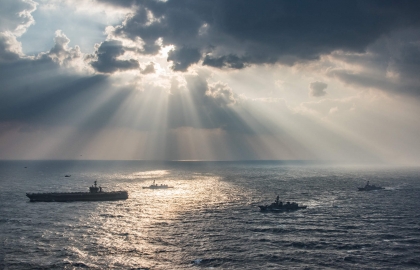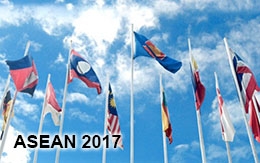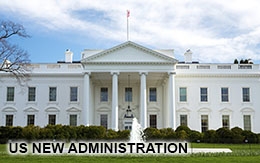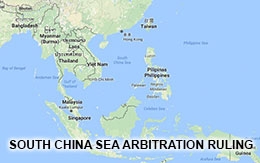Gray Zone Challenges in the East and South China Sea
Gray zone tactics have fundamentally changed the operational environment in which the United States and Asian maritime countries operate. Yet these countries remain in the early stages of developing approaches that will better enable them to credibly deter Chinese coercion.

Introduction
The United States and Japan have identified the gray zone threat as a major challenge to the international rules-based order. Given the United States’ conventional military superiority and the severe risks associated with regional war, competitors such as Russia and China—who desire to challenge U.S. predominance but remain determined to avoid large-scale conflict if possible—are adopting tactics that undermine U.S. interests but that makes conventional military responses infeasible. By relying largely on non-military capabilities and operating in what has been called a “gray zone,” these competitors confront the United States and its allies with a series of policy and strategy challenges. Thus far, the United States and regional actors have arguably yet to form a coherent policy to address the challenges.
This short policy paper seeks to provide an overview of the challenge posed by gray zone coercion in Asia and propose some principles that should guide the U.S., its allies and partners in countering the threat.
The Gray Zone Challenge in Asia
China’s use of maritime law enforcement and maritime militia to assert administrative control over disputed territory and waters in the East and South China Sea, as well as island-building activities in the South China Sea, have introduced a new doctrine of maritime coercion in Asia. This doctrine puts a premium on non-military assets and subterfuge that puts the onus of military escalation on the recipient of such tactics. China appears to calculate that relying on non-military assets such as coast guard vessels, maritime militia and other civilian maritime actors, while keeping PLA Navy (PLAN) surface ships largely in the background, will enable it to achieve its strategic goals while minimizing the risk of further escalation. Starting in 2014, China also initiated one of the most ambitious island-building campaigns in history – reclaiming over 3,000 acres of land on disputed features in the Paracel and Spratly Island chain – and building civil-military facilities on them. Several of these features now have large airstrips, hangers, radar facilities and military barracks to support military deployments in the naval and air domain. The scale and rapidity with which China achieved these island-building projects was unprecedented and caught the United States, its allies and partners off guard.
By using such tools, platforms and tactics, China has greatly improved its position and administrative control over much of the disputed territory in the East and South China Sea, and done so at minimal material or diplomatic cost. China has also been successful at “civilianizing” the optics of the threat, ensuring that if one of its rivals responds with military assets, such as with its Navy or Air Force, that country will appear to be the party engaging in escalatory behavior, rather than China. Moreover, especially in the case of much weaker rivals like the Philippines, employing naval assets in reaction to provocative Chinese maritime law enforcement or other non-military activities risks creating an opportunity for China to respond in kind, thus escalating the conflict to a level where it enjoys even more overwhelming superiority.
Chinese Gray zone tactics differ in several ways. In East Asia, territorial disputes between China and Japan over the Senkaku Islands have brought about a significant escalation of tensions over the past several years, yet China has not adopted the types of escalatory tactics or maneuvers that might lead to escalation seen in the South China Sea. China’s use of coast guard and maritime militia to change the status of Japan’s administrative control over the Senkakus nonetheless poses new gray zone challenges in the maritime and air domains in Japan’s southwest island chain. Since 2012, China has undertaken near-constant incursions into the Senkaku territorial seas test Japan’s will and resolve to respond. In particular, the recent deployment of armed Chinese coast guard cutters – many of which are decommissioned PLA Navy frigates; and the use of maritime militia fisherman whose vessels are equipped with intelligence gathering capabilities and whose personnel are under the command and control of the Navy – has injected another layer of gray zone challenge for Japan. These moves are calibrated to gauge the timeliness and readiness of the Japanese Coast Guard (JCG) to respond and compel the JCG to maintain continuous presence around the islands. For the most part, however, they follow a predictable pattern of behavior of incursions.
In Southeast Asia, on the other hand, Chinese gray zone tactics inhabit a more materially-threating form and countries in the region have grown increasingly wary of Chinese efforts to deter or in some cases actively deny the use of living and non-living resources in their exclusive economic zone (EEZs) of the South China Sea. To do so, China now actively deploys coast guard and maritime militia to protect the waters and territory within its Nine-Dash Line (NDL) claim, which has been invalidated under international law. In contrast to China’s approach near the Senkakus in the East China Sea, China adopts a much more aggressive posture in the South China Sea, in part due to Beijing’s calculation that is can coerce smaller Southeast Asian countries who in most cases do not counter-deter. The way in which China employs its coast guard, in particular, has upended conventional wisdom on the tactics of how coast guards operate. China’s coast guard is acting as a “blunt defenders of sovereignty” undertaking actions such as ramming other states’ coast guard and fishing vessels, rather than acting as traditional instruments of law enforcement. The use of its coast guard as an instrument to protect claimed territory while conducting peacetime patrols of disputed maritime territory has blurred the line between the platforms and missions associated with “law enforcement” and those associated with “national defense.” In one of the most sweeping rulings on the actions of maritime law enforcement in disputed waters on legal record, the international tribunal found that China’s coast guard had breached several UNCLOS articles governing safety and navigation at sea, striking down China’s claim that it had acted in a legal and professional manner.
Finally, China’s island-building in the Parcels and Spratly Islands and the facilities constructed on them is unprecedented in size and scope. These features now allow China to maintain a large military air and naval presence over the entire South China Sea under the guise of “civilian” purposes such as protection of the global commons, search and rescue and science observation. Since 2014, China has reclaimed over 3,200 acres of land on seven disputed features in the Spratlys, and up to 50 acres of land in disputed features in the Paracels. China has constructed the full array of dual-use facilities on these features, to include large airstrips, harbors, aircraft hangars, barracks, large communications, sensor and radar arrays, hardened shelters for missile platforms, and large underground tunnels for ammunition, water and fuel storage. By overwhelming all over claimants in terms of size of reclaimed land and military facilities in the South China Sea, China now has the capability to monitor and exert peacetime military coercion over civilian and military air and surface activities in these disputed waters.
Nine Principles Guiding a U.S. Response
These tactics have fundamentally changed the operational environment in which the United States and Asian maritime countries operate. Yet these countries remain in the early stages of developing approaches that will better enable them to credibly deter Chinese coercion.
The country that possesses largest deterrent against such actions, the United States, must assess when a more forceful response is warranted, and what the intended or united side effects of such actions. Based on findings from a forthcoming RAND report, there are nine principles that should guide the U.S. and its allies in fashioning a strategy to push back.
The first and most important strategic principle is that the United States should not merely seek to mitigate losses in the gray zone—it should aim at gaining strategic advantage. In almost all areas of gray zone competition, the United States remains in a relatively advantageous moral and material position vis-à-vis the primary aggressors of China. The U.S., therefore, should leverage all tools of statecraft to improve its relative position while controlling risks of escalation. In short, the U.S. needs to go on the offensive rather than merely remain on the defensive.
The second principle flows directly from the first: In seeking strategic advantage, the United States should be proactive rather than reactive in its approach to the gray zone challenge. Part of the problem over the last five years is that the United States has ceded initiative to China. Within the span of just a few years, China has reclaimed whole islands out of sand in the South China Sea and exerted increasing control of the sea and airspace of this vast area of water. The speed with which China reclaimed these islands caught everyone, including the United States, off guard. Furthermore, Chinese civilian, government and military vessels have significantly enlarged their presence in the East and South China Sea in an attempt to coerce other nations from operating unimpeded in contested waters. China’s success in enhancing control over the air and maritime areas of the South China Sea is due in large part to a lack of or passive U.S. and regional response.
Third, and relatedly, a core element of successful gray zone strategy is the ability to respond quickly to new provocations. The United States and its allies and partners will need to answer potential gray zone initiatives quickly and decisively without waiting weeks or even days. This requirement demands strong policy and crisis coordination mechanisms which can allow quick responses. It points to the importance of scenario development and exercising before gray zone crises occur, to game out possible answers and lay the groundwork for fast reactions. Only through forward presence with the capacity to respond rapidly will the United States and its allies have the necessary capabilities on hand for swift action.
Fourth, the United States should attempt to lead through multilateral processes and institutions even while being prepared for “go-it-alone” responses in circumstances where U.S. leadership is essential to marshal a response. Leading multilaterally can be difficult because gray zone actions affect U.S. allies and partners in more direct ways with greater national interests at stake than the United States, and those countries will have constraints on their responses that limit any joint action. Furthermore, some gray zone aggression is specifically tailored to bog down multilateral responses due to a general unwillingness to undertake overtly aggressive policies (as in the case of an ASEAN response to China). On the other hand, the primary advantage the United States enjoys is that Chinese gray zone coercion has generated significant threat perceptions in both regions that in many cases the actors themselves either cannot or do not want to respond to for fear of upsetting the aggressor, as is the case with the Philippines. Therefore, the United States should as a default approach seek to rally multilateral institutions, alliances, and coalitions of the willing to push back against China. But it should also be willing adopt a broader array of unilateral actions or actions that smaller numbers of partners may be willing to partner on, taking into account issues such as risks of escalation.
This leads to a fifth and related principle: U.S. responses must be aligned to the greatest extent possible with local partners. This may pose a significant constraint on U.S. actions, because many states in Asia have different views about the degree of threat posed by China, the degree of confrontation they are willing to undertake, and the level of partnership they will accept with the United States. The U.S. must therefore strike the right balance between accounting for such differing views and hesitations about escalation with the need for more forceful responses in that may deter gray zone actions but may in the process alienate possible allies. The United States must push back hard enough to make a difference, but not so hard that it antagonizes local partners.
Sixth, any strategy for responding to gray zone aggression must balance excessive risks of escalation—including military, diplomatic and economic aspects—with the reality that countering gray zone aggression demands some degree of risk tolerance to be effective. A dominant U.S. objective in the competition is to avoid major war. However, to achieve lasting gains against gray zone behavior, the United States and its allies must be willing put a certain amount of escalation risk on the line in pursuit of gray zone deterrence and response. In developing a more detailed strategy for gray zone responses, the United States cannot assume that the more powerful and blunt push-back is always the best; managing the threat posed to China, and overall escalation risks, must be a leading goal of the process.
Seventh, gray zone tactics are a symptom of broader regional ambitions and grievances and cannot be addressed outside that context. China is pursuing specific goals—and dealing with specific threat perceptions—in its region. Gray zone techniques are only one tool by which they are doing so. U.S. gray zone responses are about accomplishing small wins in specific areas to send a signal, not about containing an adversary in all domains. Thus, the United States is not going to “solve” the underlying cause of the gray zone dispute (for example, sovereignty of disputed territory) with China by undertaking new or innovative tactical responses. But it can buttress deterrence.
An eighth principle underpinning this proposed strategic concept is that China continues to value its status as legitimate and respected members of the international system. They are not yet willing to abandon concern about such status in exchange for unrestrained aggressive opportunities, in the gray zone or other realms. This reality provides the United States with significant leverage by making Beijing sensitive to the public costs of overtly aggressive actions in these spheres, and potentially vulnerable to powerful information campaigns designed to make them pay a reputational cost for such activities.
Finally, ninth, not all gray zone aggression has equal significance for the security of regional allies and partners, or global norms. A Chinese paramilitary assault on the Senkaku Islands would constitute a direct threat the sovereignty of an ally, whereas Chinese harassment of Filipino fisherman in Scarborough Shoal is of less immediate concern. Gray zone threats are not all created alike, and neither are their responses. Some gray zone threats require immediate action, while others may require long-term persistent dissuasion through political messaging.
Conclusion
China is increasingly turning to maritime coercion through unconventional means in East and Southeast Asia. Tactics that have traditionally fallen into binary categories of “military” and “non-military” coercion to achieve state ends no longer lend themselves to conventional constructs of analysis. The concept of a gray zone between war and peace in Asia is now a challenge that states in the region must take seriously and adopt strategies to counteract. Yet the United States and allies and partners still arguably adopt traditionalist thinking in assessing and responding to the threat. The result is a playing field sharply tilting against the United States and its allies and towards China, which is blurring the means, platforms and tactics of peacetime coercion in new and destabilizing ways.
Lyle J. Morris is a senior policy analyst at the RAND Corporation, where he focuses on security developments in East and Southeast Asia. He has over ten years of experience researching and leading projects on Asia-Pacific security issues and has published recently on the rise of coast guards in East and Southeast Asia, gray zone disputes, maritime security in the Asia-Pacific, and Chinese military modernization.
Click here for pdf file










